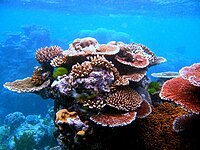
Photo from wikipedia
Seagrasses provide an important ecosystem service by creating a stable erosion-resistant seabed that contributes to effective coastal protection. Variable morphologies and life-history strategies, however, are likely to impact the sediment… Click to show full abstract
Seagrasses provide an important ecosystem service by creating a stable erosion-resistant seabed that contributes to effective coastal protection. Variable morphologies and life-history strategies, however, are likely to impact the sediment stabilization capacity of different seagrass species. We question how opportunistic invasive species and increasing grazing by megaherbivores may alter sediment stabilization services provided by established seagrass meadows, using the Caribbean as a case study. Utilizing two portable field-flumes that simulate unidirectional and oscillatory flow regimes, we compared the sediment stabilization capacity of natural seagrass meadows in situ under current- and wave-dominated regimes. Monospecific patches of a native (Thalassia testudinum) and an invasive (Halophila stipulacea) seagrass species were compared, along with the effect of three levels of megaherbivore grazing on T. testudinum: ungrazed, lightly grazed and intensively grazed. For both hydrodynamic regimes, the long-leaved, dense meadows of the climax species, T. testudinum provided the highest stabilization. However, the loss of above-ground biomass by intensive grazing reduced the capacity of the native seagrass to stabilize the surface sediment. Caribbean seagrass meadows are presently threatened by the rapid spread of the invasive opportunistic seagrass, H. stipulacea. The dense meadows of H. stipulacea were found to accumulate fine sediment, and thereby, appear to be effective in reducing bottom shear stress during calm periods. This fine sediment within the invasive meadows, however, is easily resuspended by hydrodynamic forces, and the low below-ground biomass of H. stipulacea make it susceptible to uprooting during storm events, potentially leaving large regions vulnerable to erosion. Overall, this present study highlights that intensive megaherbivore grazing and opportunistic invasive species threaten the coastal protection services provided by mildly grazed native species. Synthesis. Seagrass meadows of dense, long-leaved species stabilize the sediment surface and maintain the seabed integrity, thereby contributing to coastal protection. These services are threatened by intensive megaherbivore grazing, which reduces the stability of the surface sediment, and opportunistic invasive species, which are susceptible to uprooting in storms and thereby can leave the seabed vulnerable to erosion.
Journal Title: Journal of Ecology
Year Published: 2020
Link to full text (if available)
Share on Social Media: Sign Up to like & get
recommendations!